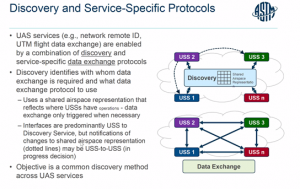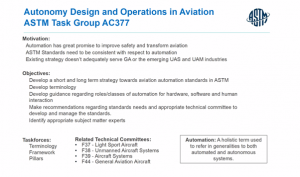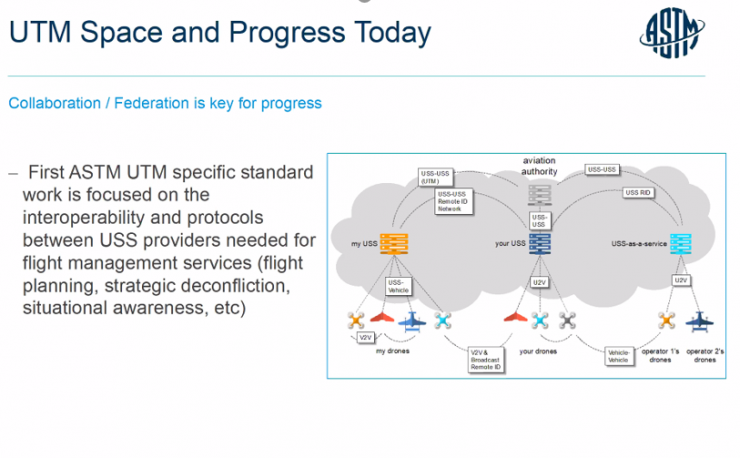EUROCAE hopes to publish by the end of the year a new standard – ED-282 E-Identification for drone operations in the “open” category for security purposes, according to Christian Schleifer-Heingärtner, Secretary General of EUROCAE, speaking at a “Standards Landscape” webinar organised by the Global UTM Association (GUTMA) on 27 October. The webinar has come at a crucial time for the UTM industry as multiple standards organisations have been working on developing UTM standards around the world, mostly as part of a coordinated activity but sometimes in parallel. GUTMA is playing an important role in helping align UTM standards development.
“I find it crucial to engage with all standard development organizations to ensure compatibility of their work and avoid duplication of efforts. These needs were raised by several members within GUTMA and the webinar session was GUTMA’s first step in this direction!” said Eszter Kovacs, Acting Secretary General of GUTMA.
The new EUROCAE standard is complementary to – and references – ASTM and ASD-STAN work in this area. But it goes slightly further. “This standards gives more functions: more conflict management, more geofencing and situational awareness,” said Christian Schleifer. It is also linked to other EUROCAE standards work around urban air mobility and counter-UAS.
EUROCAE has the mission statement “to develop the necessary standards to enable the safe integration of all types of UAS into all classes of airspace” and has already published ED-270 (geocaging) ED-269 (geofencing) and ED-267 (Detect and Avoid at Very Low level – which provides the link to UTM and U-Space) to show compliance with regulations. The organisation is also working on an acceptable means of compliance for VTOLs, which also has links to UTM standards development work.
| ED-282 (CR) includes definition of the following safety data-sets
· Situational awareness, conflict management, geofencing and other essential services such as monitoring, emergency management, recording and analysis. It considers four categories of data: · Dynamic status data (latitude, longitude, altitude, velocity etc) · Identification and static data (identification, capability, health status etc) · Intention data (next waypoint etc) · App specific data (take–off point etc) MOPS minimum requirements – range, resolution, accuracy, refresh rate – are also included along with guidance on the validation of end-to-end data exchange. |
ASTM – which published its standard for remote identification of drones for security and compliance in February 2020 (https://www.unmannedairspace.info/latest-news-and-information/astm-international-publishes-standards-for-remote-id-and-tracking-of-drones/) – will be publishing its first UTM standard next year, according to Phil Kenul, Chair of ASTM’s F38 UAS Committee. This will be based on “interoperability and protocols needed for flight management services (flight planning, strategic deconfliction and situational awareness).”
“There has been a lot of communications between the standards bodies to ensure there is no duplication,” he said. “We recently signed an MoU with ASD-STAN to allow them to use without any constraints the broadcast version of the remote ID standard…for use by the open category in Europe. This is a good step forward in cooperating and working together.”

“UTM is a big elephant and there will room for lots of SDOs to support one cohesive architecture,” he said. The discovery and synchronisation service is an example of this, with ASTM developing a new foundational standard to allow UTM service suppliers to share safety critical data.
UTM standards work at ASTM is also addressed by working group AC377, working on autonomy in areas such as airworthiness in design and construction of aircraft, training, detect-and-avoid and operations over people. “One standard that we recently published was on durability and reliability which will support UTM operations in the future in the USA,” he said. ASTM’s working group on urban air mobility also covers UTM in its operations and technology work-streams.

“One of things we are looking at within GUTMA is how we handle this interoperability issue and global harmonisation to make sure there’s a place for all standards development organisations”, said webinar moderator and GUTMA board member Amit Ganjoo of ANRA Technologies. “We’re helping facilitate these organisations synchronise their efforts.”
John Walker, chair of the International Organization for Standardization (ISO)/TC 20/SC 16 Unmanned Aircraft Systems working group said: “One of the interesting aspects of the committee is that it mirrors committees of national standards organisations, especially in Japan, China and Korea. It’s extremely important that we have this relationship of sharing information.”




